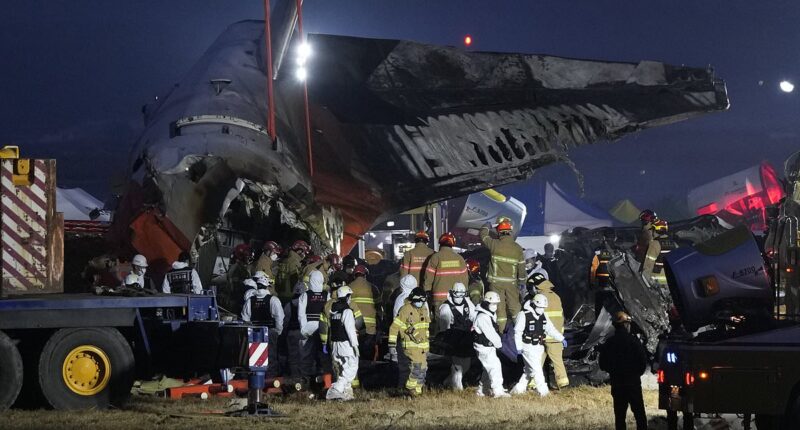
The heartbreaking last words of a passenger on the doomed Jeju Air flight that crashed, so far killing 179, have been revealed.
Flight 7C2216 operated by Jeju Air, had 181 individuals onboard as it arrived from Bangkok, Thailand. The aircraft was making an approach to land at South Korea’s Muan International Airport around 9 a.m. (0000 GMT) when it deviated from the runway path. The plane ultimately collided with a wall and burst into flames.
A distressing message was transmitted by a passenger to a family member, informing them that a bird had become trapped in the plane’s wing. The situation escalated when the individual sent a final text questioning whether they should prepare to speak their last words.
This aviation incident stands as the most severe involving a South Korean carrier since the tragic Korean Air crash in Guam back in 1997, which resulted in the loss of over 200 lives according to data from the transportation ministry.
The twin-engine Boeing 737-800 can be seen in video from local media skidding down the runway with no apparent landing gear before slamming into a wall in an explosion of flame and debris. Other photos showed smoke and fire engulfing parts of the plane.
Investigators are looking into bird strikes and weather conditions as possible factors. Local media cited airport authorities as saying a bird strike may have caused the landing gear to malfunction.
Senior Transport Ministry official Joo Jong-wan said workers have retrieved the flight data and cockpit voice recorders of the plane’s black box, which will be examined by government experts investigating the cause of the crash and fire.
The control tower issued a bird strike warning and shortly afterwards the pilots declared mayday, a transport ministry official said, without specifying whether the flight said it struck any birds.
About one minute after the mayday call the aircraft made its ill-fated attempt to land, the official said.
Thirty-two fire trucks and several helicopters were deployed to contain the fire. About 1,560 firefighters, police officers, soldiers and other officials were also sent to the site.
Lee Hyeon-ji, a response team officer at the local fire department, said the death toll would likely continue to rise ‘due to the critically injured’.
Hours after the crash, mortuary vehicles were lined up to take bodies away, and authorities said a temporary morgue had been established.
The crash site smelled of aviation fuel and blood, according to Reuters witnesses, and workers in protective suits and masks combed the area while soldiers searched through bushes.
Yonhap news agency cited a fire official as saying most of 175 passengers and six crew were presumed dead.
Authorities had worked to rescue people in the tail section, an airport official told Reuters shortly after the crash.
Two crew members, a man and a woman, were rescued from the tail section of the burning plane, Muan fire chief Lee Jung-hyun told a briefing. The fire was extinguished as of 1 p.m., Lee said.
‘Only the tail part retains a little bit of shape, and the rest of (the plane) looks almost impossible to recognise,’ he said.
Authorities have switched from rescue to recovery operations and because of the force of the impact, are searching nearby areas for bodies possibly thrown from the plane, Lee added.
The passengers included two Thai nationals and the rest are believed to be South Koreans, according to the transportation ministry.
The Boeing 737-800 jet, operated by Jeju Air, was manufactured in 2009, the transport ministry said.
Jeju Air CEO Kim E-bae apologised for the accident, bowing deeply during a televised briefing.
He said the cause of the crash was still unknown, that the aircraft had no record of accidents and there were no early signs of malfunction.
The airline will cooperate with investigators and make supporting the bereaved its top priority, Kim said.
No abnormal conditions were reported when the aircraft left Bangkok’s Suvarnabhumi Airport, said Kerati Kijmanawat, president of Airports of Thailand.
Founded in 2005, Jeju Air is a low-cost airline that operates international routes to Japan, Thailand, and the Philippines, in addition to numerous domestic flights.
Boeing said in a emailed statement, ‘We are in contact with Jeju Air regarding flight 2216 and stand ready to support them.
‘We extend our deepest condolences to the families who lost loved ones, and our thoughts remain with the passengers and crew.’
The U.S. Federal Aviation Administration did not immediately respond to a request for comment.
All domestic and international flights at Muan airport had been cancelled, Yonhap reported.
South Korean acting President Choi Sang-mok, named interim leader of the country on Friday in an ongoing political crisis, arrived at the scene of the accident and said the government was putting all its resources into dealing with the crash.
Two Thai women were on the plane, aged 22 and 45, Thai government spokesperson Jirayu Houngsub said, adding that details were still being verified.
Thai Prime Minister Paetongtarn Shinawatra sent condolences to the families of the dead and injured in a post on X, saying she had instructed the foreign ministry to provide assistance.
The ministry said in a statement it was in touch with the South Korean authorities.
The Foreign Office has confirmed to MailOnline that no Britons were on board the flight.
The last time South Korea suffered a large-scale air disaster was in 1997, when a Korean Airline plane crashed in Guam, killing 228 people on board. In 2013, an Asiana Airlines plane crash-landed in San Francisco, killing three and injuring approximately 200.
Sunday’s accident was also one of the worst landing mishaps since a July 2007 crash that killed all 187 people on board and 12 others on the ground when an Airbus A320 slid off a slick airstrip in Sao Paulo and collided with a nearby building, according to data compiled by the Flight Safety Foundation, a non-profit group aimed at improving air safety.
In 2010, 158 people died when an Air India Express aircraft overshot a runway in Mangalore, India, and plummeted into a gorge before erupting into flames, according to the safety foundation.

















